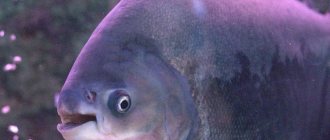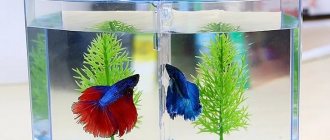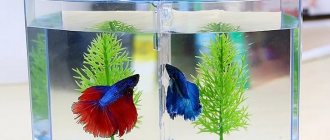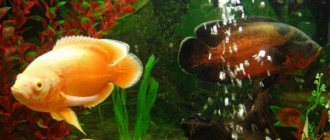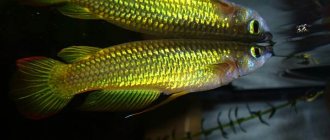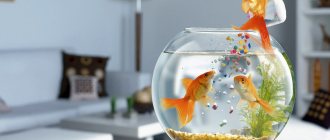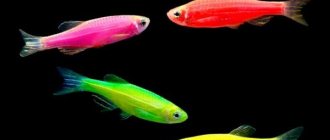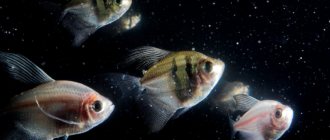Home » Interesting collections about animals
A live aquarium is a decoration for any home. And you can populate it not only with fish; there is a large selection of other possible inhabitants that can be purchased at a reasonable price.
- 2 Freshwater shrimp
- 3 Freshwater crabs
- 4 Tritons
- 5 Table: approximate cost of aquarium inhabitants
Snails
Melania sandis is a viviparous snail that lives on the sandy bottom of a pond or aquarium. The intensity of its reproduction is affected by the temperature of the content - the most comfortable is 26 - 28°C. The appearance of the shell is a spirally twisted cone about 7 cm long. The color is pearl gray, sometimes with a pink tint. The drawing consists of dark strokes and dots.
Melania feeds on semi-decomposed organic matter, so keeping it in an aquarium helps purify the water. In addition, by loosening the sandy soil, it helps saturate it with oxygen.
Due to its appearance, the snail almost blends in with the ground and is difficult to notice.
Ampularia is a large, brightly colored snail. It is not difficult to maintain, but there are some features:
- with good care, the snail reaches a large size (up to 10 cm) and multiplies quickly, so for each individual ampularia it is necessary to provide at least 10 liters of aquarium volume;
- These mollusks are scavengers; many species of fish, crayfish and shrimp are very aggressive towards them and cannot be kept together.
The most common color of ampularia is yellow, but there are other types: white, brown, black, blue
Physa vesicularis (or pimply) is one of the most unpretentious snails. It lives in European reservoirs, so it can get into an aquarium even by accident - with live food or a plant. The pimply physa feeds on organic matter and improves the condition of water. But it has a big drawback - it multiplies very quickly and can overfill the aquarium if measures are not taken to remove excess individuals.
The color of the physeal can be very attractive, but it differs from all similar shells in that its curl goes from left to right, and not from right to left.
Dimensions of small reservoirs and their purpose
Even the smallest fish aquarium should be equipped with the necessary devices:
- filter;
- aerator;
- heater;
- lighting.
The advantages of small tanks include the following:
- compactness;
- easy care;
- convenient transportation.
However, miniature reservoirs also have disadvantages. First of all, due to the small volumes, it is impossible to contain many inhabitants in the vessel. Secondly, the water in small aquariums gets dirty faster, so you will have to carefully monitor cleanliness and order. In tanks with a large volume, water changes are not as noticeable as in tiny ones, where any changes in environmental parameters lead to stress for the fish.
Freshwater shrimp
The structure of all shrimp is the same. They differ in size (from 0.5 to 35 cm) and color. These freshwater fish are great for cleaning the aquarium and fighting filamentous fish, as they eat everything. Filamentous algae are thin, thread-like algae that multiply quickly and can fill the entire aquarium.
Amano are algae-eating shrimp. They are small in size (3 – 6 cm). The body is translucent gray-blue with small dots or strokes. Keeping them in an aquarium is easy, but breeding them can be difficult. Despite the fact that adult shrimp live in fresh water bodies, their larvae hatch into the sea.
Amano are compatible with all shrimp except Mahrobrachium, although there are conflicts with other species
Harlequin - small shrimp (6 - 13 mm) with an unusual coloring, reminiscent of a clown costume. They differ in their demands on the environment:
- hardness: 7 – 8 pH;
- temperature: 27 - 28°C (at 26°C they can already die);
- complete absence of nitrates and sulfates in the water.
These mollusks do not tolerate proximity to other species.
Harlequin shrimp spawn only in very clean water, and if the water quality does not suit them, the female will shed all her eggs
White pearl is a shrimp that was bred specifically for the aquarium, and keeping it is not particularly difficult. The appearance of the shrimp fully justifies its name: it has a white or translucent body with a pearlescent tint and looks good with green algae. It is very peaceful and does not pose a threat to other inhabitants, but predatory fish may consider it lunch.
Under acceptable conditions, White Pearl females are capable of producing offspring every 1.5 months
Axolotl (water dragon)
These are the most interesting animals for an aquarium. Axolotls reach only 15 cm in length, in rare cases - 30 cm. In appearance, they are slightly reminiscent of salamander larvae due to the characteristic external gills and caudal fin. The head of a water dragon is flattened and wide, there are no eyelids on the eyes, and there are small teeth. The limbs are poorly developed.
Water dragons come in 4 colors: 2 natural shades and 2 artificial ones. Natural colors are brown with spots and black. The ones that have been bred include light pink and gold.
In the wild, the axolotl feeds on insects, small fish, and worms. In captivity, its diet may consist of trout pellets, bloodworms, and live or thawed earthworms. The water dragon likes small shrimp and beef liver.
Axolotls determine the location of food by smell. Having discovered it, they pull it in with great force. You should not place other animals in the same aquarium with a water dragon: small neighbors can be eaten, and large fish can cause harm (they often gnaw on the gill stalks and appendages of the axolotl while it sleeps, which can lead to infection).
The water dragon lives at a temperature of +14...+20°C. If the animal is sick, the indicator should be reduced to +10°C to avoid an increase in the pet’s appetite. To create a microclimate in the aquarium, it is recommended to use a special cooling unit, a filter and a water purifier from chlorine.
1 individual should be kept in a 50 liter container with a water level of 150 mm. It is permissible to use an aerator. It is necessary to change 20% of the water weekly. It is not advisable to line the bottom with fine gravel, because the axolotl can swallow stones.
The aquarium should contain floating plants that the pet will use as shelter, and small caves. Too much light is not required because the water dragon is a nocturnal animal.
Freshwater crabs
Crabs are marine animals, but there are several species that have adapted to life in fresh water.
Dwarf crab (spider crab) - its size excluding claws does not exceed 1.5 cm. It gets along well in an aquarium with fish, does not eat algae, and is nocturnal.
The color of the Dwarf crab varies from light gray to gray-green and depends on the conditions of detention.
The Dutch crab is a small crab (3 - 4 cm), not very aggressive and can live with fish or other inhabitants that do not encroach on its territory. It is not very difficult to maintain, but is known to be a pest of aquarium plants, as it often damages their root system.
The Dutch crab is always in search of food; it eats with great pleasure various food intended for fish, and even their waste products.
Rainbow is a large (up to 20 cm) tricolor crab with bright colors. Doesn't get along with neighbors. His aquarium must have dry areas, as he does not like to stay in water for a long time.
The color of the rainbow crab is very bright: the carapace is blue, the claws are gray or blue, the paws are orange to bright red, the abdomen is white and blue.
Features of keeping crayfish at home
For 1 arthropod, a container of 30-40 liters is enough. If you plan to house several individuals, the minimum volume should be 80 liters. Shelters such as a cave or a pot are installed in the home. Crayfish eat each other, especially during the molting period, so there must be enough places where the animals can hide.
To purify water, it is better to use an internal filter, because crayfish can easily get out through the hoses, and without liquid they do not live long. In addition, the aquarium must be tightly covered.
Crayfish are given special food. Once a week they are pampered with pieces of fish fillet and shrimp.
It is not worth feeding protein foods often, because they increase aggressiveness.
It is not recommended to keep crayfish together with fish, because the latter will soon be eaten.
Tritons
Only a few species of these amphibians are kept at home.
Common newt. It is relatively small (up to 11 cm). It can coexist with other inhabitants, but it is necessary that the temperature conditions of the housing coincide, since newts prefer 18 - 22 ° C, and even lower in winter.
Newts are predators, they will be happy to taste small live fish, crickets, earthworms, and they eat frozen bloodworms well
The spiny newt is larger than the common one and can reach a length of 23 cm. The conditions of detention are approximately the same as for the common one. But this amphibian is dangerous with its poison, and you cannot pick it up with your bare hands.
On the sides of the spiny newt there are pointed ends of the ribs, which, when in danger, secrete a very burning substance that can cause a severe allergic reaction.
Octopus at home
The octopus is an intelligent exotic animal. In captivity it grows up to 20-25 cm in diameter. The mollusk requires a housing with a volume of at least 350 liters with filters that not only purify the water, but also make its chemical composition optimal.
Constant aeration is also important. Octopuses are demanding on water quality. Coarse sand and coral chips are poured onto the bottom in a layer of 7-9 cm.
There should be shelters for the octopus in the aquarium. The container must be covered with a lid or plastic grill. Provide moderate or dim lighting and completely exclude sunlight.
Octopuses remember their owner. But you need to approach your pet quietly and slowly so as not to scare him and prevent ink from being released.
Otherwise you will have to change the water. Under poor conditions, the animal gets sick. The mollusk's body becomes lighter, it stops eating and goes into its shelter.
Unusual aquarium fish
- The black knife is one of the most unusual types of fish. In captivity it grows up to 50 cm, so it needs a spacious aquarium. There are practically no fins and no vision. Creates a small electric field around itself, thanks to which it finds food for itself. It feeds on bloodworms and mussels.
- The dragon wrasse is an exotic fish with an aggressive nature. It is active only during the daytime; at night it buries itself in the sand or freezes in place. For a young individual, 250 liters of volume is required, for an adult - from 500 liters. It feeds on the meat of sea fish, squid, and mussels. You need to give food 3 times a day.
- The blue dolphin is a calm aquarium inhabitant that grows up to 25 cm in length. This fish requires a container with a volume of 400 liters or more. Meat feed should be given in small portions up to 5 times a day.
- The box fish is shaped like a cube. It grows up to 45 cm. In nature, it feeds on algae and small crustaceans, so in captivity the diet can be combined.
The most common inhabitants of aquariums
|
|
